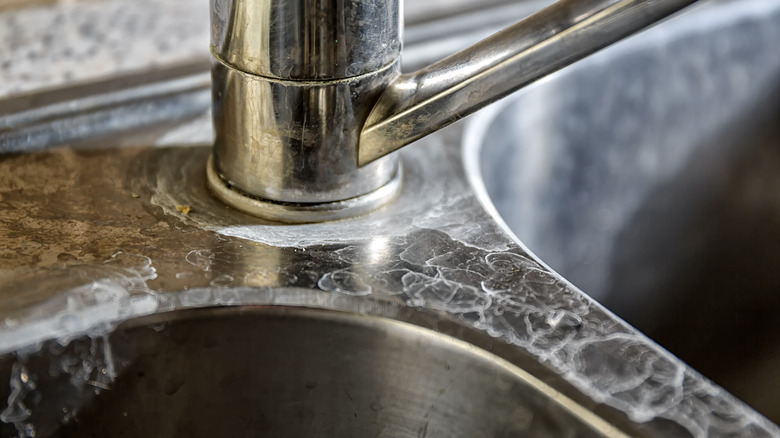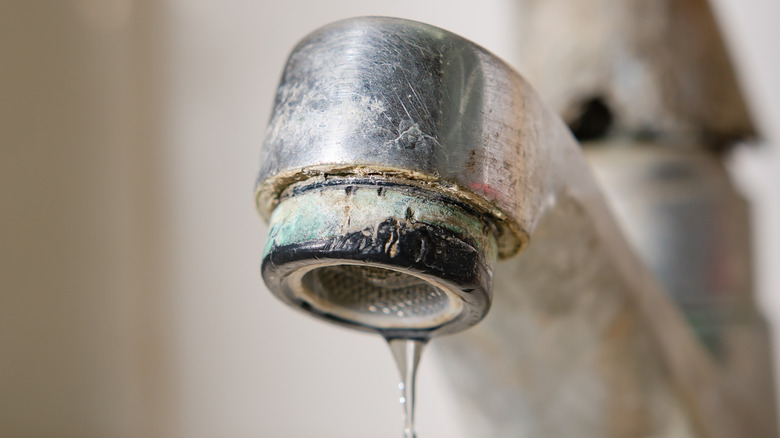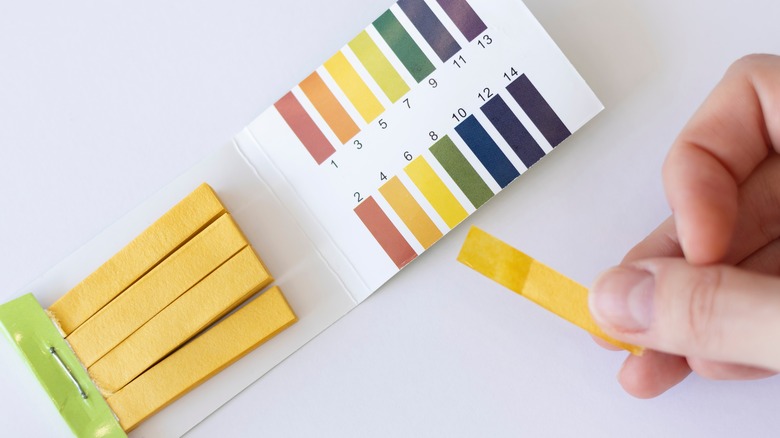What It Means If You Find Unsightly Mineral Deposit Stains In Your Sink
If you've started playing peekaboo with a noticeable stain in any tub or sink in your house or on the pipes themselves, that signals a problem. If the stain looks green or greenish-blue, your pipes might be corroding and are most likely made from copper (or brass, which is a zinc-copper alloy). When copper is exposed to the air, it turns green, letting you know that the mineral copper is leaching from your pipes and into your water. The tint may not be visible when you turn on the tap, but your sink, faucet, and pipes are racking up the evidence. There are several potential causes for that corrosion. On the other hand, maybe your stainless steel sink has developed a white film or white gunk has accumulated around the faucets. This is limescale, another type of mineral deposit. The good news is you can do something about both.
Starting with the more complex copper issues first, sometimes our copper pipes can contain standing, and therefore stagnant, water, and this starts a corrosion process. Think about it this way: If your pipes are corroding, it means they're disintegrating. So not only is the copper leaking into your water, but so is the actual pipe. Copper can also leach out of brand-new pipes, often for about a year until a natural oxidation process occurs, coating the pipes and halting the process. But aside from stagnant water, another major underlying reason behind copper corrosion is problematic water.
Causes of those green blobs and white junk
Acidic water causes much corrosion to pies, leading to pitting of the metal and even minuscule leaks. Or sometimes our water has elevated levels of chlorides, aka salts, which can come from different sources. Coastal areas may have higher chloride levels, but it could also come from the groundwater, runoff from salts that are used seasonally on the roads, or from septic system pollution. Another corrosion source and serious health concern is the presence of lead. Alternatively, when your house or apartment was being built, it's possible that a renegade gang of plumbers improperly fitted the copper pipes during installation. For every cause described, there's a straight line between pipe corrosion, the leaching of copper, and the resulting blue-green stains in your sink.
Moving on to different mineral deposits, a whopping 85% of the United States has what is called hard water. Hard water creates limescale (aka calcium, magnesium, or manganese carbonate), the white-beige droplets most visible on steel sinks after the water evaporates. It leaves behind telltale signs that it's lurking by also leaving chunky, clay-like deposits on shower heads. It can accumulate inside pipes, possibly causing corrosion. If no bacteria have accumulated inside the pipes, this mineral-rich concoction is not harmful to drink or bathe in. The original cause of hard water can be traced to the chemical processes that result from rocks dissolving in rivers, lakes, wells, and reservoirs.
How to clean deposits and test your water
Whether you've got a white film on your stainless steel sink, beige crystals forming on faucets or your shower head, or blue-green stains in the sink, there's a fix. You can use a natural cleaner made from vinegar and baking soda to lift any mineral deposit stains. In a large non-metal bowl, combine 1 ½ cups of baking soda with 2 tablespoons of white vinegar and three drops of liquid castile soap and make a paste. Leave it for 20 minutes or more and then scrub, rinse, and don't forget to dry.
If you've spotted even a hint of green or green-blue staining in your sink or tub, it's a good idea to purchase a few at-home tests. Start with testing the pH level to check for too much acidity – Walmart's pH kit typically retails for about $14. Separately test for lead too. Fresh Water Systems sells multiple water test kits, including for lead and chloride.
To find out about overall water quality, consider getting a TDS meter, a device that measures total dissolved solids including chloride, minerals, fluoride, and heavy metals. HM Digital's TDS meter sells on Fresh Water Systems for $16. 500 parts per million is the maximum TDS level for safe drinking water; it should be below that. The TDS meter alone won't tell you about a specific thing like chloride though, so consider getting a test, too. Finally, speak with a qualified plumber about filtration or other solutions to tackle copper or calcium carbonate corrosion.


